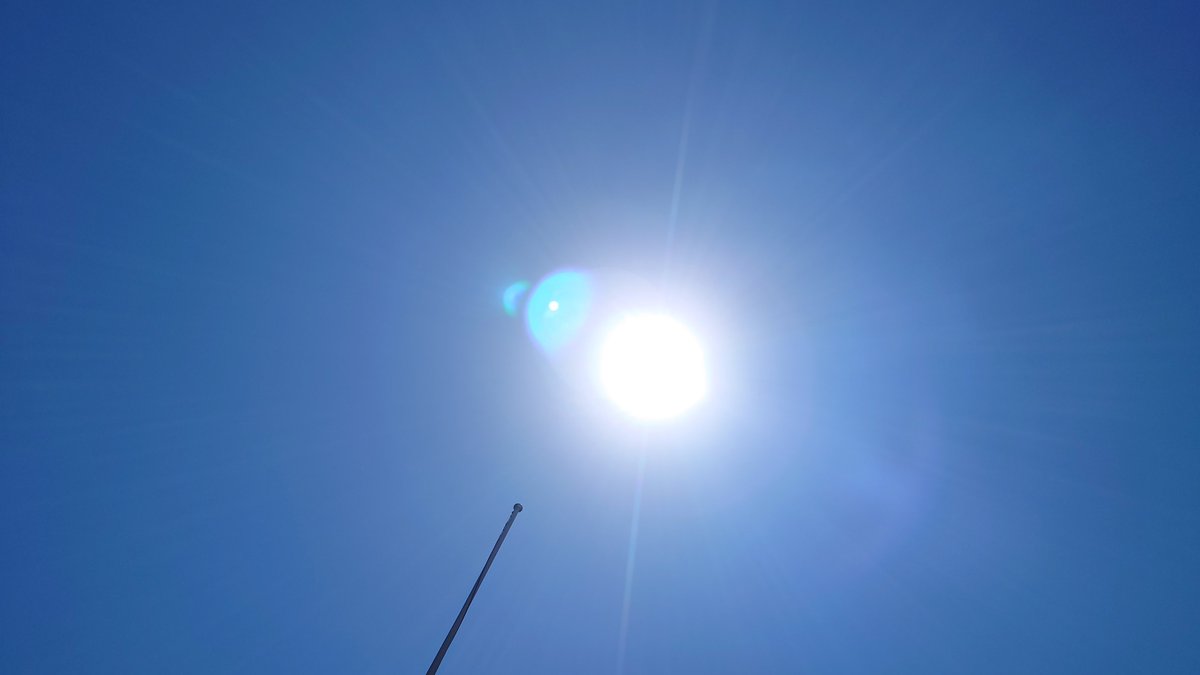もしもある日突然太陽が消えたら。ちょっと疑問

以前、YouTube動画で『ある日突然太陽が消えたら地球はどうなるのか?』という動画を見ました。そして少し前にもYouTube動画のおすすめで似たような動画が表示されたので見ました。さらに最近、また似たような動画を見ました。だいたい動画で触れている内容は似たような内容でした。
ここでひとつだけ先に注意を書いておきます。太陽が消えるというのは、太陽が何らかの理由で爆発して消滅するということではなく、突然手品のようにその場から消えてなくなるという意味です。

YouTube動画で見た動画での大雑把な説明では、まず太陽が忽然と消えても地上にいる私たちは、およそ 8分 20秒は太陽が消えたことに気づくこともなく普通に日常生活を送っているというものです。これは地球と太陽の距離がおよそ 150,000,000キロメートルも離れているためです。光の速度でも地球から太陽まで到達するのはおよそ 8分 20秒かかります。私たちが普段地上から見ている太陽は、およそ 8分 20秒前の太陽なのです。
太陽が消えておよそ 8分 20秒経つと、太陽の恩恵を受けている昼間の地域では突如暗くなってしまいます。天気の良い地域ならば、青空が突然の夜空に変わってしまい、何が起きたのかすぐには理解できないでしょう。また夜の地域に居る方は昼間の地域に居る方のようにすぐには気づけないかもしれませんが、もし月が見える夜ならば、突然月の輝きが失われてしまい、何が起きたか理解できず、またいつまで経っても太陽が昇ってこないので徐々に不安になるでしょう。そして人類はパニックに陥ります。
政治家や有識者が協議するとか、そういう話もありましたが、その辺りは省略させていただきます。
太陽がなくなると太陽光を利用して植物が行っていた光合成ができなくなります。そして植物は枯れ始めます。大木などはすぐに枯れないそうですが、光合成が行われないということは二酸化炭素が増えても酸素を生成することができないので、酸素が枯渇することを意味しています。ただし酸素がすぐさま無くなることはないそうです。なぜなら人類が一年間で消費する酸素の量は 6,000,000,000,000キログラムなのですが、現在の地球には 1,000,000,000,000,000,000キログラムを超える 20万倍弱の酸素があるそうです。
ただし、ここで個人的に思うのは、酸素を消費している生命は人間だけではないし、植物だって光合成をしていない時には呼吸をしていて酸素を消費しているわけですから、人類の消費量だけで比較するのは間違っているのでは? と私は考えています。少し個人的な意見を差し込んでしまって話を長くしてしまいました。すいません。
気温については一気に冷えます。熱が放出されるだけで、熱を受け取ることができないので温度はだんだん下がり、一週間ほどで地峡全体の平均気温は零度ほどになります。
この間、人類が太陽がなくなったことを正しく理解し、電力の生成や供給を続けることができれば、ある程度の死者は出るものの、人類がすぐさま滅亡するということはないそうですが、一週間で温度が大きく下がることで人間以外の動植物の犠牲も増えるでしょうから、ここまではなんとか生き延びられたとしても、寒さだけではなく食糧難なども起きるためにここら先はこれまでのような生活では生き延びれないでしょう。
そして、太陽が消えてから一年後には地球の平均気温はマイナス 73℃まで低下すると言われています。この寒さになるとさすがに人類が生き延びるのは難しいでしょう。仮に電気の供給で暖房器具などが家にあったとしてもマイナス 73℃の外気温から快適な温度まで上げるほどの暖房器具があるのか疑問ですし、外に出るには宇宙服のような防護服を着ないと呼吸しただけで肺臓が凍るとも言われています。
太陽が消えて一年も経つと地表の海も凍りつくと言われています。氷の厚みは 10メートルかそれ以上になるとも言われています。そんな冷えた地上でも火山活動が活発な地域、間欠泉など熱が放出されているところでは暖が取れる可能性があるようです。
この頃に人類が生き残っているとすれば、太陽がなくなった早い段階で地下に巨大な空間を用意していて、そこに居住地だけでなく、電力を生成および供給できるシステムを構築していて、太陽光に近い人工の光を用意していて植物もきちんと育てることのできる環境を用意していた場合に限られるでしょう。食料や飲料水を確保し空気や衛生環境も整えることができていれば、ごく少数の人間だけは生き延びている可能性もあるかもしれません。しかし、これは極めて可能性の低い展望だと思われます。
もし地球の生物で生き残る者がいるとすれば海の底の方の熱水噴出孔に生息する生物ぐらいだろうと言われています。地球の表面の海がぶ厚い氷に覆われてしまった後も、その下には液体の
水が存在すると言われており、極限微生物は熱や硫黄やメタンといったものをエネルギーにして生きることができるそうです。
さらに太陽が消えてから 10年以上が経過すると地球はどんどん冷えていき、ついには酸素や窒素といった、いまは大気中に漂う気体が液体になり地表に降り注ぐようになるそうです。そして降り積もった酸素などは固体となってしまいます。
また、太陽がなくなった時点で、太陽の重力波の影響を受けなくなった地球は公転周回軌道から外れて一直線に進むことになるそうです。このときどの方向に進むかは太陽が消えたタイミングによって決まってしまいます。もし星の数が多いとされる天の川銀河の中心に近い方向に移動する場合は、どこかの恒星の重力につかまって、たまたまハビタブルゾーンで周回軌道に乗るという奇跡を起こせれば、海面の氷が少しずつ溶け、窒素や酸素なども固体から液体、液体から気体になって再び地球が息を吹き返す ( ? ) かもしれません。その時に地下で生存を続けていた人類がもし居れば、再び地上で生活を送れる日が来るかもしれない。
とても長い話になりましたが、以上が太陽が突然消えてしまったら何が起きるか? 人類はどうなるのか? という動画の内容になるのです。太陽が突然消えてしまっても、人類はすぐに絶滅するわけでもなく、暴動などが起きて人類の手によって早期に人類が滅亡するという選択をした場合は論外ですが、衣食住の確保の問題を解決できれば、人口が大幅に減っても数か月は滅亡には至らないということでした。また技術力などで地下で電力なども含め自給自足を維持できれば一年以上人類が生存することも可能だという話でした。
しかし、私はこれらの話には疑問を抱かざるを得ません。
まず、動画の話では太陽が突然消えてしまっても、8分 20秒後に昼間の地域にいる人は、突然太陽の光がなくなり暗くなったことに驚くという話で、これはその通りだと思います。ですが、太陽がなくなって公転軌道を外れて地球が一直線に進むような事態になれば、おそらく月も地球のまわりを公転することなく直線に進んで行くと思うのです。そのとき月が地球にぶつかることがあればその時点で人類は滅脳するでしょうし、地球と月が衝突しなくてもかなり接近しただけでお互いの引力により地球は大きな被害を被ると思います。仮に月が地球に近づくことなく離れていったとしても、いまの地球は太陽や月の影響を大きく受けているはずなので、これらの星を失えば地球は安定しないでしょう。
地球の地軸は 23.5度傾いていますが、これは太陽に対しての傾斜で、太陽が消えてしまうと地球の地軸も不安定になると思います。それに自転もどうなるのかもわからないですよね。不安定になれば速度がどうなるかもわからないですし。そうなると地震や火山の噴火、あるいは大津波やとんでもない強風など、天変地なのでしょうか?
太陽が消えて地球が直線に進んでいくというのに、空が暗くなるとか寒くなるという程度で地球が安定した状態で人類が一週間それなりの生活を送っているという状況に無理があると思うのですが、どうでしょう? また木製のような大型惑星もどこか直線に進んでいくので、それらの影響も受けなくなる地球が無事に済むとは思えません。
また、地球の大気なども一部は失われるのではないかと思うのですが、地球の気温の低下ももっと早いような気がするのですが、この動画のシミュレーションって、どういう計算で導き出したのだろうか?
Excuse:
Including this green text, the following text is a translation of the Japanese article above, done by Using an Internet translation service. There may be parts that have a different meaning in the translation. I apologize for any such instances.
What if the sun suddenly goes out one day? A little doubt
I previously watched a YouTube video titled “What If the Sun Suddenly Disappeared?,” and more recently, I came across similar recommended videos on YouTube and watched them as well. The content discussed in these videos was mostly alike. Before delving further, it’s essential to clarify one thing. When we refer to the Sun disappearing, we do not mean that it would explode or vanish due to some explosion. Instead, it signifies a sudden and magical disappearance from its location.

According to a rough explanation from a YouTube video I watched, if the Sun were to suddenly disappear, we, who are on Earth, would continue with our daily lives without realizing the disappearance for approximately 8 minutes and 20 seconds. This is because the distance between Earth and the Sun is about 150,000,000 kilometers. Even at the speed of light, it takes about 8 minutes and 20 seconds for light to travel from the Sun to Earth. The Sun we see from the ground is actually the Sun from about 8 minutes and 20 seconds ago.
Approximately 8 minutes and 20 seconds after the Sun disappears, daytime regions benefiting from the Sun’s light will suddenly become dark. In areas with clear weather, the blue sky will change abruptly into a night sky, and people may not immediately grasp what has happened. Those in nighttime regions might not notice right away, similar to those in daytime regions, but if it’s a night with a visible moon, the moon’s glow will suddenly vanish, leaving them puzzled and increasingly anxious as the Sun fails to rise. Eventually, panic sets in among humanity.
There were discussions among politicians and experts, but I will omit the details about that.
If the sun were to disappear, plants would no longer be able to perform photosynthesis, which relies on solar energy. As a result, plants would start to wither. Larger trees, however, may not wither immediately. The absence of photosynthesis means that even with increased carbon dioxide levels, they would be unable to generate oxygen, leading to oxygen depletion. Nevertheless, oxygen depletion wouldn’t happen instantly. This is because the amount of oxygen consumed by humanity in one year is approximately 6,000,000,000,000 kilograms, while the Earth currently has over 1,000,000,000,000,000,000 kilograms of oxygen, which is about 200,000 times more than humanity’s annual consumption.
However, personally, I believe that it might be incorrect to compare oxygen consumption solely based on human beings, as other life forms also consume oxygen. Even plants respire and consume oxygen when they are not photosynthesizing. So, comparing it only to humanity’s consumption seems flawed, in my opinion. I apologize for inserting a personal opinion and making the explanation longer.
The temperature drops suddenly. Since heat is only being emitted without being received, the temperature gradually decreases, and within about a week, the average temperature throughout the region becomes around zero degrees Celsius.
If humanity can properly comprehend the disappearance of the sun and continue to generate and supply electricity, it is said that although there will be some casualties, immediate extinction of humanity is not likely. However, within a week, the significant drop in temperature will likely lead to an increase in the number of casualties among non-human animals and plants. Even if survival is somehow managed up to this point, the challenges ahead, such as food shortages in addition to the cold, will make it impossible to continue living as we have before.
It is said that one year after the sun disappears, the average temperature on Earth will decrease to minus 73 degrees Celsius. With such extreme cold, it would be extremely difficult for humanity to survive. Even if there were heating appliances supplied with electricity at home, it is doubtful whether there would be heaters capable of raising the temperature to a comfortable level from the outside temperature of minus 73 degrees Celsius. Moreover, going outside without protective clothing similar to a spacesuit would be dangerous, as it is said that breathing in such cold air could freeze the lungs.
It is said that one year after the sun disappears, even the surface seas will freeze. The thickness of the ice is said to be around 10 meters or even more. However, in regions with active volcanic activity or places where geysers and hot springs release heat, there may still be possibilities to find warmth amid the cold conditions on the ground.
If humanity were to survive around this time, it would be limited to only those who had prepared massive underground spaces early on when the sun disappeared. They would have constructed a system capable of generating and supplying electricity, not only for living spaces but also for providing artificial light similar to sunlight. In this environment, they would have been able to properly cultivate plants. To have a chance of survival, they must have secured food, drinking water, and established a clean air and sanitary environment. Although there is a slim possibility that a very small number of humans might have survived, this is considered an extremely unlikely prospect.
If there were any living beings to survive on Earth, it is believed that they would most likely be organisms inhabiting the deep-sea hydrothermal vents. Even after the surface oceans of the Earth are covered with thick ice, it is said that liquid water still exists below, and extremophiles can survive by utilizing heat, sulfur, methane, and similar substances as energy sources.
Furthermore, after more than 10 years since the disappearance of the sun, the Earth will continue to cool rapidly, eventually causing gases such as oxygen and nitrogen, which currently exist in the atmosphere, to liquefy and fall to the surface. Oxygen and other gases will accumulate as solids.
Moreover, at the point when the sun disappears, the Earth, no longer influenced by the sun’s gravitational waves, will veer off its orbital path and move in a straight line. The direction it takes will depend on the exact moment the sun vanishes. If by chance it moves in a direction closer to the center of the Milky Way galaxy, where numerous stars are believed to exist, and if it happens to be captured by the gravity of some star and miraculously enters the habitable zone in orbit, then there is a possibility that the ice on the surface may gradually melt, and nitrogen, oxygen, and other elements may transition from solid to liquid and then gas, reviving the Earth once again (maybe?). If any human survivors were living underground at that time, there might be a chance for them to return to the surface and resume life someday.
It has been a very long discussion, but the above is the content of the video about what would happen if the sun suddenly disappeared and what would become of humanity. Even if the sun were to suddenly vanish, humanity wouldn’t go extinct immediately, unless humans choose to bring about their own early demise through riots or such, which is unthinkable. If the issues of clothing, food, and shelter can be resolved, even with a significant reduction in population, it was suggested that humanity could survive for several months. Furthermore, if self-sufficiency, including power generation underground, can be maintained through technological capabilities, it was discussed that humanity could survive for more than a year.
However, I cannot help but have doubts about these discussions.
First, in the video’s explanation, it is said that even if the sun suddenly disappears, people in daylight areas would be surprised by the sudden darkness after 8 minutes and 20 seconds, and I believe this to be true. However, if the sun were to disappear and the Earth were to deviate from its orbit and move in a straight line, I think the moon would probably also continue on a straight path without orbiting the Earth. In that case, if the moon were to collide with Earth, humanity would be wiped out instantly, and even if the Earth and moon did not collide, just a close approach would cause significant damage to Earth due to their mutual gravitational forces. Even if the moon were to move away from Earth without coming close, our current Earth is greatly influenced by the sun and moon, so losing these celestial bodies would destabilize our planet.
t seems unrealistic that even if the Sun were to disappear and the Earth moved in a straight line, humanity would continue to lead a relatively stable life with only changes like the sky getting dark or the temperature dropping for a week. Moreover, large celestial bodies like gas giants would also be moving in some direction, so it’s hard to believe that Earth would remain unscathed without being affected by their influences.
Furthermore, I wonder if some parts of the Earth’s atmosphere would also be lost, and the decrease in Earth’s temperature would happen much faster. I’m curious about the calculations and simulations used to derive the scenarios presented in this video.

この記事へのコメントはありません。